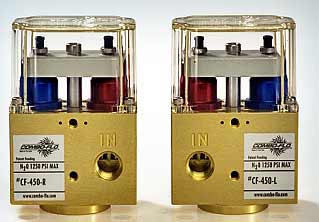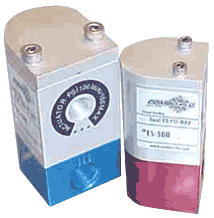Airnoid Choices
The Comb-Flo Line features 2 basic styles of Airnoids. The Combo-Flo Silver and Gold versions have the fuel and nitrous circuits combined in one compact Airnoid. The 500 series are individual Airnoids available for use where an independent circuit control or layout consideration is needed.
 Silver 400 Series Silver 400 Series
The Combo-Flo Silver has the inlets and the outlets on opposite sides. These would fit any nozzle or plate that would require that the fuel and nitrous enter from the same side and exit the opposite side. This Airnoid accepts ¼ npt nitrous inlet and 1/8 npt outlet fittings. The fuel side is 1/8 npt on both sides. The orifice size is .156 on both nitrous and fuel and the piston lift off of the seat is and astounding .080. Weight is 303 grams or 10.7 ounces. To put the weight in perspective, the 2 electric solenoids that the Airnoid is designed to replace weigh in at a porky 750 grams (26.5 oz).
The center to center distance on the outlet holes is 1.375. I include this dimension so you may see if you can change over simply or need to change the tubing also on a nozzle system.
Gold 450 series
 The Gold Airnoid is available with left and right hand versions and is a bottom outlet design. It is designed as a direct replacement for electric solenoids on current nozzle systems but can be used on any configuration that needs the fuel and nitrous to enter from opposite sides of the Airnoid. The left hand/right hand feature allows you to keep your fuel lines coming in from the front of the car and the nitrous from the rear. Inlet port sizes are ¼”npt and the bottom outlet ports are 1/8”npt. They share the same orifice size as the Silver at .156 but have a higher flow rate due to the bottom outlet. Plunger lift is .080 and the weight is 344 grams or 12.1 ounces. The outlet hole center to center distance is 1.875. The Gold Airnoid is available with left and right hand versions and is a bottom outlet design. It is designed as a direct replacement for electric solenoids on current nozzle systems but can be used on any configuration that needs the fuel and nitrous to enter from opposite sides of the Airnoid. The left hand/right hand feature allows you to keep your fuel lines coming in from the front of the car and the nitrous from the rear. Inlet port sizes are ¼”npt and the bottom outlet ports are 1/8”npt. They share the same orifice size as the Silver at .156 but have a higher flow rate due to the bottom outlet. Plunger lift is .080 and the weight is 344 grams or 12.1 ounces. The outlet hole center to center distance is 1.875.
500 Series
 Single purpose nitrous and fuel Airnoids are used when a combined unit is not practical or individual activation is desired. If independent activation of the nitrous and fuel Airnoid are needed an actuator will be required for each. The nitrous Airnoid has ¼” npt inlet and 1/8”npt bottom outlet while the fuel version has a 1/8”npt inlet and outlet. The fuel Airnoid is available in a bottom outlet or conventional horizontal outlet. The respective weights are 10 oz for the nitrous and 5.8 oz for the fuel. The Nitrous Airnoid has a .218 orifice with .125 plunger lift while the fuel checks in with a .156 orifice and .100 of plunger lift. Single purpose nitrous and fuel Airnoids are used when a combined unit is not practical or individual activation is desired. If independent activation of the nitrous and fuel Airnoid are needed an actuator will be required for each. The nitrous Airnoid has ¼” npt inlet and 1/8”npt bottom outlet while the fuel version has a 1/8”npt inlet and outlet. The fuel Airnoid is available in a bottom outlet or conventional horizontal outlet. The respective weights are 10 oz for the nitrous and 5.8 oz for the fuel. The Nitrous Airnoid has a .218 orifice with .125 plunger lift while the fuel checks in with a .156 orifice and .100 of plunger lift.
Airnoid Function
 You may be wondering about the mechanics of the Airnoids. The Airnoids all function the same basic way. Rather than cut up a perfectly good part I whipped up an illustration of the Gold bottom outlet version. There is an air cylinder at the bottom where the co2 comes in. The area of the piston (#1) has enough area to pull open the both the fuel and nitrous sides with ease against a rated 1250 psi. When co2 or air is applied the activation piston pushes the rod the T bar (#2), up which in turn, pulls up the plungers (#3). When the system is shut off, the left over co2 air is expended out relief holes (not shown) to the atmosphere and the spring (#4) forces the plungers closed against the seat. It doesn’t get much simpler. You may be wondering about the mechanics of the Airnoids. The Airnoids all function the same basic way. Rather than cut up a perfectly good part I whipped up an illustration of the Gold bottom outlet version. There is an air cylinder at the bottom where the co2 comes in. The area of the piston (#1) has enough area to pull open the both the fuel and nitrous sides with ease against a rated 1250 psi. When co2 or air is applied the activation piston pushes the rod the T bar (#2), up which in turn, pulls up the plungers (#3). When the system is shut off, the left over co2 air is expended out relief holes (not shown) to the atmosphere and the spring (#4) forces the plungers closed against the seat. It doesn’t get much simpler.
|
